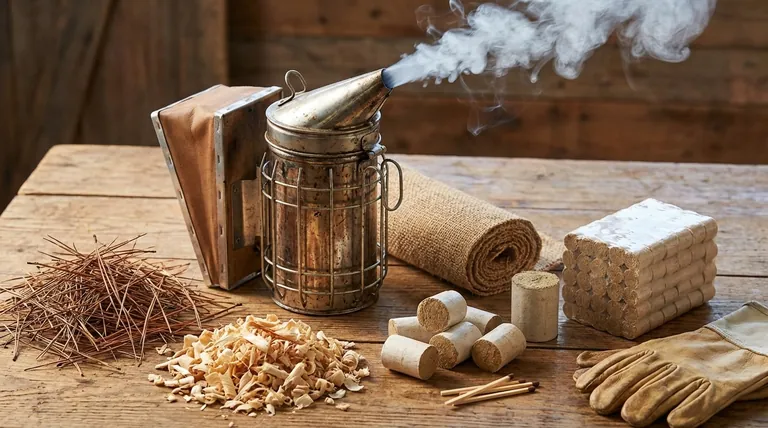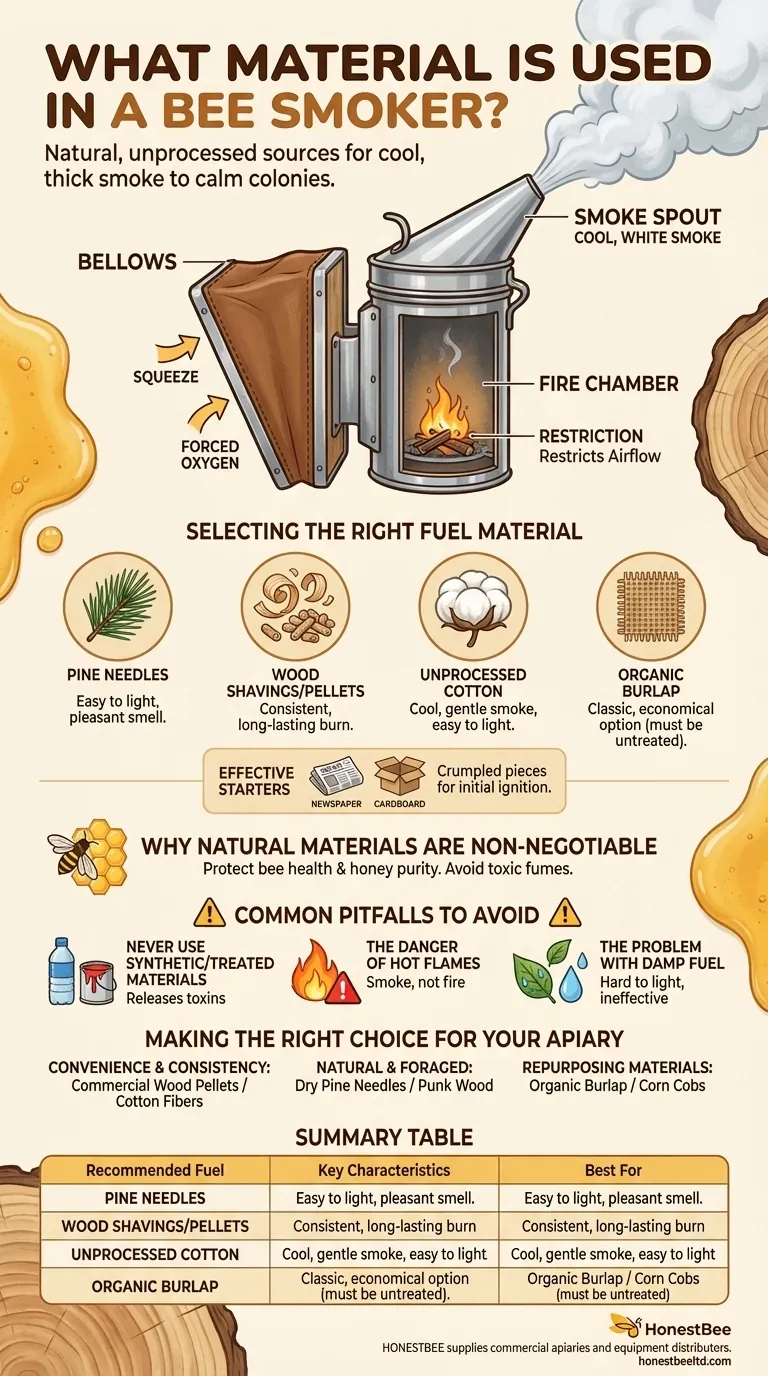The most common materials used for bee smoker fuel are natural, unprocessed sources that produce a cool, thick smoke. Beekeepers frequently use dry pine needles, wood shavings, unprocessed cotton fibers, organic burlap, and specialized wood pellets to calm their colonies during inspections.
The key to selecting a bee smoker fuel isn't finding one "perfect" material, but understanding the principle: you need a non-toxic, natural fuel that smolders slowly to produce cool, white smoke, which calms bees without harming them or contaminating the hive.

How a Bee Smoker Creates Calming Smoke
To choose the right fuel, it's essential to understand how the device works. The smoker is engineered not to create a fire, but to sustain a slow, oxygen-starved smolder.
The Fire Chamber
The main body of the smoker is a metal fire chamber. It's designed to hold the fuel and restrict airflow, preventing the material from bursting into open flames. This ensures the fuel smolders for a long time.
The Bellows
The attached bellows are the engine of the smoker. Each time you squeeze them, a puff of air is forced into the bottom of the fire chamber, providing a burst of oxygen. This injection of air causes the smoldering fuel to produce a large volume of thick, white smoke on demand.
The Goal: Cool, White Smoke
The combination of a smoldering fire and forced air produces the ideal smoke for beekeeping. It is cool enough not to harm the bees and thick enough to effectively mask the alarm pheromones they use to communicate danger, keeping the colony calm.
Selecting the Right Fuel Material
While many natural materials work, the best fuels share common characteristics: they are easy to light, burn slowly and consistently, and are free from contaminants.
Common and Recommended Fuels
These are proven, reliable options used by beekeepers everywhere.
- Pine Needles: When completely dry, they light easily and produce a pleasant-smelling, effective smoke.
- Wood Shavings or Pellets: Untreated wood shavings or commercial smoking pellets offer a very consistent and long-lasting burn.
- Unprocessed Cotton: Raw cotton fibers are a popular commercial option known for being easy to light and producing a cool, gentle smoke.
- Organic Burlap: Strips of natural burlap (from old sacks, for example) are a classic fuel, but you must ensure they have not been treated with chemicals.
Effective Starter Materials
To get your primary fuel smoldering, you need a starter that catches fire easily. Small, crumpled pieces of newspaper or untreated cardboard work perfectly for this initial step.
Why Natural Materials Are Non-Negotiable
The health of your bees and the purity of your honey depend on using clean fuel. Any material that has been treated, painted, or is synthetic can release toxic fumes into the hive, harming or killing the bees and contaminating the wax and honey.
Common Pitfalls to Avoid
Choosing the wrong fuel can be ineffective at best and disastrous at worst. Understanding what to avoid is as important as knowing what to use.
Never Use Synthetic or Treated Materials
Do not burn plastic, synthetic fabrics, pressure-treated wood, glossy paper, or anything containing glue or chemicals. These materials release toxins that are dangerous for both the bees and the beekeeper.
The Danger of Hot Flames
The goal is smoke, not fire. If your smoker is producing open flames from the spout, the smoke is too hot and can burn or agitate the bees. You need a smolder, not a blaze.
The Problem with Damp Fuel
Green or wet fuel is extremely difficult to light and keep smoldering. It will produce a steamy, ineffective smoke and can go out easily, frustrating your efforts during a hive inspection. Always use materials that are completely dry.
Making the Right Choice for Your Apiary
Your choice of fuel will often depend on your location, budget, and personal preference.
- If your primary focus is convenience and consistency: Commercially available wood pellets or unprocessed cotton fibers provide a reliable, long-lasting burn.
- If your primary focus is using natural, foraged materials: Dry pine needles, punk wood, or dry leaves are excellent, cost-effective options found in many environments.
- If your primary focus is repurposing common materials: Scraps of organic burlap, corn cobs, or untreated cotton rags can serve as effective and economical fuel sources.
Ultimately, the best fuel is one that is dry, natural, and allows you to confidently manage your hives with a gentle hand.
Summary Table:
| Recommended Fuel | Key Characteristics | Best For |
|---|---|---|
| Pine Needles | Easy to light, pleasant smell | Foraging/eco-friendly beekeepers |
| Wood Pellets/Shavings | Consistent, long-lasting burn | Reliability and convenience |
| Unprocessed Cotton | Cool, gentle smoke, easy to light | Gentle handling, commercial use |
| Organic Burlap | Classic, economical option | Repurposing common materials |
Ensure your apiary's success with the right supplies. Choosing the correct, natural fuel is just one part of effective hive management. HONESTBEE supplies commercial apiaries and beekeeping equipment distributors with high-quality, reliable beekeeping supplies and equipment through our wholesale-focused operations. Let us help you equip your operation for efficiency and bee health.
Contact HONESTBEE today to discuss your wholesale supply needs and keep your colonies thriving.
Visual Guide

Related Products
- 54-Piece Smoker Fuel Pellets for Beekeeping Beehive Smoker Fuel
- Economy Galvanized Beekeeping Honey Bee Smoker for Wholesale
- Professional Bee Smoker with Elongated Spout and Durable Bellows for Beekeeping
- Stainless Steel Honey Bee Smoker Hive and Honeycomb Smoker for Beekeeping
- Premium Traditional Copper Bee Smoker with Bellows
People Also Ask
- What to put in a bee hive smoker? A Guide to Natural, Calming Fuels
- What can I use for bee smoker fuel? Choose Safe, Natural Materials for a Calm Hive
- What fuels are recommended for beehive smokers? Master the Art of Calm, Controlled Inspections
- What are important considerations when choosing smoker fuel? A Guide to Safe, Effective Beekeeping
- What is best to burn in a bee smoker? Master the Layered Fuel Technique for Calm Hives



















